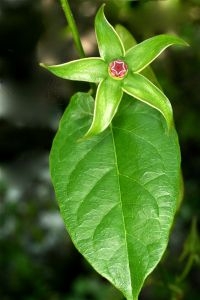
Nieuwe endemische plantensoort ontdekt op St. Eustatius
Bericht uitgegeven door Dutch Caribbean Nature Alliance (DCNA) [land] op [publicatiedatum]
Op St. Eustatius is een geheel nieuwe plantensoort ontdekt, Gonolobus aloiensis, van het Griekse 'gonos' (zaad) en het Latijnse 'lobus' (peul) en naar de naam die de Arawak-indianen het eiland St. Eustatius gaven: 'Aloi', wat cashewboom betekent. De ontdekking werd gedaan in het kader van de langetermijnstudie van de vaatplanten van St. Eustatius door STENAPA en de Universiteit van Puerto Rico.
Lees verder in het Engels…
 The ongoing study of the vascular plant flora of St. Eustatius by STENAPA and the University of Puerto Rico has resulted in the discovery of a new species never described before by science, named Gonolobus aloiensis; the genus name coming from the Greek ‘gonos’ (seed) and Latin ‘lobus’ (pod) and the species name from ’Aloi’, the Arawak name for St. Eustatius, meaning cashew tree.
The ongoing study of the vascular plant flora of St. Eustatius by STENAPA and the University of Puerto Rico has resulted in the discovery of a new species never described before by science, named Gonolobus aloiensis; the genus name coming from the Greek ‘gonos’ (seed) and Latin ‘lobus’ (pod) and the species name from ’Aloi’, the Arawak name for St. Eustatius, meaning cashew tree.
So new it still lacks a common name, Gonolobus aloiensis can be described as a vine from the climbing milkweed family (Asclepiadaceae). It is endemic to St. Eustatius and its discovery represents the first record of this genus for the island, expanding the endemic biodiversity of St. Eustatius with yet another species and proving that even on our small Dutch Caribbean islands, not all biodiversity has been charted yet.
The plant can be easily distinguished from the six other Lesser Antillean Gonolobus species by its shorter and narrower lobes and the presence of ‘glandular hairs’, or trichomes, on the top two-thirds of the lobes.
The Gonolobus genus is comprised of an estimated 100 – 150 species. On the Lesser Caribbean islands, around ten species of Gonolobus can be found, all endemic to the region of which eight are single island endemics. Now a ninth can be added to that list. Only occurring inside the Quill volcano crater rim, this newly discovered species has just surpassed the Statia Morning Glory as the rarest plant species within the Kingdom of the Netherlands.
Since its habitat, the walls of a dormant volcano crater, is hardly accessible, at the moment it is not possible to estimate the exact population size of G. aloiensis for conservation purposes. Possible threats include the goats that roam about the crater and the unlikely eruption of the volcano. However unlikely, at eruption the entire population of G. aloiensis would be wiped out. Therefore the authors recommend attempts be made to grow G. aloiensis in botanical gardens to ensure its preservation. To begin with, STENAPA will try to cultivate it in the Miriam C. Schmidt Botanical Garden on St. Eustatius.
Source: Krings, A.; Axelrod, F.S. (2013) Gonolobus aloiensis (Apocynaceae, Asclepiadoideae), a New Species from St. Eustatius. Systematic Botany 38(4): 1132–1137.
Read the entire article in BioNews
Text: Dutch Caribbean Nature Alliance (DCNA)
Photo: Carol Gracie
Published by: Dutch Caribbean Nature Alliance (DCNA)
Nederlandse inleiding: Paul Westerbeek, Dutch Caribbean Nature Alliance
